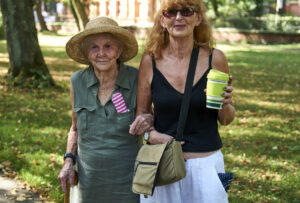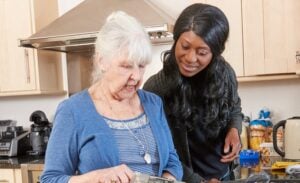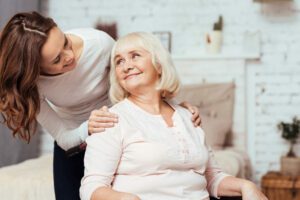Home adaptations for the elderly
Tags
Elderly Mobility and Independence
Did you know the home is the most common location for an accident to happen? Or that 2.7 million people in the UK require a hospital visit following an accident in the home each year? As we age the risk of accidents, particularly falls, can increase due to things like poor balance, weaker muscles, and conditions such as hypertension, which can cause dizzy spells.
It’s important for us all to evaluate our homes for hazards as we get older, and make adaptations to improve safety. In this guide we cover the things to look out for.
Small adaptations to make life easier
There are a few simple things you can do to make your or your loved one’s home that little bit better to be in.
1. Improve lighting
Wherever there’s an opportunity throughout the home, let as much natural light as possible pour into living spaces. This will not only make visibility easier, but it can also help establish natural rhythms of night and day, aiding sleep. Ensuring rooms are properly lit during the darker hours is essential to reducing trips, falls, and confusion too. You can do this by –
- replacing dark heavy curtains with blinds
- adding mirrors to reflect light around the room (bear in mind mirrors can be upsetting to those with dementia)
- upgrading lightbulbs to LED bulbs, which can give a brighter light for the same wattage as other bulbs
- painting rooms and dark furniture a lighter colour
- adding lamps to seating areas, and beside the bed
- replacing older light switches with ones that are easier to grip
- adding motion activated lighting in hallways
2. Create clear contrasts
Whether it’s furniture, floor rugs, towels in the bathroom, or bedding, choosing clear block colours and avoiding any complex stripes or patterns can make it easier to distinguish between items and areas. This can be especially important for people living with dementia or poorer eyesight.
3. Clear up any clutter
Obviously, what counts as clutter can be subjective, and if you’re supporting a loved one they may not agree that their home is cluttered at all. However, too much clutter can cause problems. It can pose a tripping hazard, hide pest infestations, impact the flow of clean air around the home and be a potential fire risk. It can also make it more difficult for emergency services to access the home if something unexpected happens. If you’re concerned about a loved one’s home, having a gentle conversation about these things may help them view items differently. Avoid using triggering language such as ‘junk’ or ‘clutter’, and ask them what they want to do with items, and whether there is a cupboard or safer place to store things that are in the way. It’s also good practice to –
- keep all pet accessories (bowls, toys etc.) in one room as much as possible
- secure the corners and edges of rugs to the floor, placing slip resistance pads underneath
- remove loose wires, or tack them to skirting boards to keep them safe
4. Keep things clean
It can become more difficult to keep on top of cleaning as we age – certain tasks can take a lot of energy, strength, or stretching, and remembering to do things regularly can be tricky too. However, cleaning is essential to minimising the risk of illness or infection, especially if a person has a weaker immune system. If you’re helping a loved one you may want to offer some weekly support with the following –
- checking the fridge and cupboards for expired items
- Creating a schedule for reoccurring domestic tasks to help build a memorable routine. e.g empty waste paper bins on Monday morning, or put a dark load of laundry on on Wednesday afternoon
- ensuring essential cleaning items are kept in a visible and accessible place. Labelling drawers or cupboards can help too
- putting unnecessary items away. e.g if a loved one has lots of bath towels they may not do any laundry until they run out. Keeping just a couple out for use can help prevent this becoming overwhelming
5. Make the kitchen more comfortable
- as a lot of the time in the kitchen is spent stood up, add a perching stool, chair or somewhere comfortable to sit
- move commonly used items to lower cabinets and drawers, label drawers and cupboards to make finding things easier
- ask a plumber to install lever taps that can more easily be turned on and off
- check the dials and switches on appliances like the oven and washing machine, if the writing in worn consider adding stickers, or highlighting the most used settings with a permanent marker
- wide-handled cutlery, high-rimmed plates and two-handled cups can be easier to grip for people with arthritis or tremors
- specially adapted appliances – such as a rocking kettle can eliminate the need to lift heavy items and can help prevent scalding
- If eating meals in a dining room or living room, a trolley can make transporting hot food safer
6. Keep things cosy
Living in a cold home can be dangerous to health. There are a number of ways you can help keep the home warm, as well as energy-efficient measures you can take to ensure you or your loved one isn’t paying over the odds on their energy bills.
- arrange regular boiler checks to ensure their heating system suitable and is working properly
- if the home doesn’t have double glazing, add draught excluders and window insulation film to keep cold air out, and prevent warm air escaping
- add loft insulation. You may be eligible for financial support for loft and cavity wall insulation through this Government scheme
- check electric heaters and blankets are under 10 years old and are being used correctly. Never leave an electric heater unattended or close to loose fabrics. Ensure electric blankets aren’t folded as this can damage the internal wiring

Getting started with larger home adaptations
Usually, an occupational therapist is the first port of call if you need to make bigger changes around the home. Occupational therapy aims to improve your ability to do daily tasks and supports independent living.Therapists can recommend new ways of tackling tasks, types of specialist daily living equipment to use, and changes you can make around the home.
Depending on your situation, you get occupational therapy for free either through the NHS (speaking to your GP or a doctor at hospital) or through your local social services. If you don’t want to wait for occupational therapy, you can arrange it privately, however there will be costs involved.
An occupational therapist will look at your or your loved one’s home and assess how they navigate the it, and their overall living conditions. They’ll then write a report on what changes they think would make your life easier.
An occupational therapy assessment may look at things like –
- How you access and use your home, including how you’re supported by others, and how you use any items of equipment you already have
- The techniques you use to carry out certain tasks
After evaluating your needs, they should be able to indicate the kind of adaptations to make, as well as pointing you in the direction of any funding.
The kind of changes you’ll need to make to the home will vary widely depending on the severity of your or your loved one’s condition.
What improvements may be needed around the home?
Here we’ll go round some of the most important rooms in the house, and some of the changes an occupational therapist may suggest, or that you may choose to make independently.
Elderly adaptations in the bathroom
The bathroom can pose a big risk of a fall – water and smooth flooring isn’t a great combination. Luckily, there are several adaptations that can be made to make this room safer.
- thermostatic mixer taps allow for a specific maximum temperature to be set – they can be installed by a plumber
- adding grab rails around the bath, shower and toilet, and a bath seat can offer additional support. Installing a hoist can make getting into the bath safer, but will using one will usually require the assistance of a carer
- an accessible bath and walk-in shower (also called a level access shower) can remove the need for someone with stiff joints or weakness from having to step up or lift their legs high
- When someone has memory issues, bathrooms can flood easily. Adding flood detectors will raise an alarm once water in a sink or bath reaches a certain height
Some people choose to create a downstairs bathroom for easier daytime access, however this can involve major construction work which can be costly and difficult for an older person to live with. You may want to consider moving a loved one in with family temporarily while doing major adaptation work on their home.

Elderly adaptations in the bedroom
The bedroom may not pose as many hazards, but there are things that can help make it more comfortable.
- If incontinence is a worry, keeping a bedpan to hand, and fitting the bed with a waterproof mattress and waterproof sheets can help
- Hoists and other transfer aids can help raise and lower people in and out of bed. Mobile hoists can be moved for use in a variety of rooms. Again, a carer will be needed to use the hoist, and it’s important that they are properly trained to do so
- Fitting automatic or motion sensor lighting helps ensure a nighttime wakeup doesn’t result in a difficult walk in the dark, which could increase the risk of a fall
Elderly home adaptations in the kitchen
The kitchen is obviously one of the more dangerous rooms in the home. While it’s rarely possible to remove every risk if a loved one lives alone, there are things you can do to make things safer.
- lowering kitchen worktops and adding wheeled work surfaces
- consider installing an oven with an induction hob – these will only heat up on contact with a metal pan, and don’t retain dangerous temperatures once the pan is removed
- install additional lighting in areas where higher risk tasks happen, such as chopping food or pouring hot liquids
- consider installing an isolator switch that you can programme to switch off the cooker and hob after a certain length of time
Home care considerations
If you have a professional carer visiting, or staying in the home through live-in care there are a few things you can do to make providing care easier and more comfortable for them.
- keep items they’ll need each day in the right places, for example keep all medications in a bathroom cabinet, and keep essential cleaning products in the same kitchen cupboard
- create a weekly household chore list or planner to help them understand what tasks need to be completed and when
- ensure you have extra bedroom for a live-in carer to have the sole use of. It’s important they have a comfortable space to relax in that doesn’t need to be accessed by other members of the household
- When a carer first starts, adding post-its to offer prompts and guidance around the home can be a big help. For example if there’s a preferred setting on the washing machine, or highlighting where the stop-cock is if they need to turn the water off in an emergency.
Funding for housing adaptations
All of these changes can be expensive. Luckily, your local authority should be able to cover the cost of smaller home adaptation up to the cost of £1000. This isn’t a means-tested benefit, so you should be eligible regardless of income.
This includes changes like installing grab rails, some types of ramp, and additional safety lighting.
You’re also able to get more extensive modifications to your home with Disabled Facilities Grants. This financial assistance is also provided by your local authority and can help pay for work to make your home more accessible such as widened access, bathroom re-modelling and stairlifts.
These improvement grants can be up to the value of £30,000, but are dependant on certain eligibility criteria, including household savings and income.
It’s essential you wait for your grant application to be confirmed before beginning work on your property – otherwise, you may find you’re no longer eligible.
Using a home improvement agency
Home improvement agencies (HIAs) are dedicated to enabling elderly, vulnerable and disabled people to lead rich and fulfilling lives. They offer impartial advice, provide guidance on the type of adaptations you need, arrange the work, and support installation fees and the cost of repairs. They can also help with energy saving measures to keep homes warm and reduce heating bills.
You can find your nearest HIA by contacting –
England
Foundations – The national body for home improvement agencies
Find my HIA – a national directory of agencies across England, and a source of information and advice.
Wales
Care and Repair Cymru – a welsh charity helping older people arrange home repairs and adaptations.
Scotland
Care and Repair Scotland – offering technical and financial support to older people who’s homes no longer suit their needs.
Sources
https://livingmadeeasy.org.uk/dlf-factsheets/adapting-your-home-the-kitchen
https://www.scope.org.uk/advice-and-support/home-adaptations-occupational-therapist-assessments/
https://www.alzproducts.co.uk/bath-sink-water-alarm
Read more later life articles

12 summer safety tips for the elderly
It’s important for everyone to take care in hot weather – anyone can become unwell if they’re exposed to soaring temperatures. However, for older people

Live-in care vs other types of care
Live-in care vs other types of care Navigating elderly care options for a loved one is a significant decision. While care homes are a common

Defining Dignity in Later Life – Interview with Liz Lloyd
We talked to Liz Lloyd about personal and social perceptions of age, the challenges of identity, empowerment and choice.

The Challenges of Vegetarians and Vegans Living with Dementia
We talk to Amanda Woodvine about the challenges faced by older vegetarians and vegans receiving care. Read more here.

How much does live-in care cost?
How much does live-in care cost? Live-in care provides one-to-one support in the comfort of your loved one’s home, but how much does it cost?

How much does respite care cost?
Respite care offers short-term relief for primary carers, and the cost can vary widely depending on the type of care, location, and level of support
Read more care guides

How to prepare for a live-in caregiver
Care at home: how to prepare the home for a live-in caregiver A live-in carer can make a massive difference to your loved one’s quality

6 tips for finding the right live-in carer
Finding the right live-in carer is a significant and deeply personal decision, impacting your loved one and the entire family. You’re seeking someone trustworthy, compassionate,

The cost of care – everything you need to know
The true cost of care – everything you need to know Discover the true cost of care and explore your funding options with our care

Understanding autism in older adults
While Autism is usually diagnosed in childhood, an increasing number of older adults are being formally diagnosed in later life. Masking autism symptoms can result

A guide to speaking with a loved one about home care
Why do older adults resist care? A guide to speaking with a loved one about home care Bringing up the topic of care at home

How to choose the right personal alarm for seniors: A comprehensive guide
Personal alarms for elderly Discover how personal alarms work, who they’re best suited to, and how they provide greater peace of mind to older people